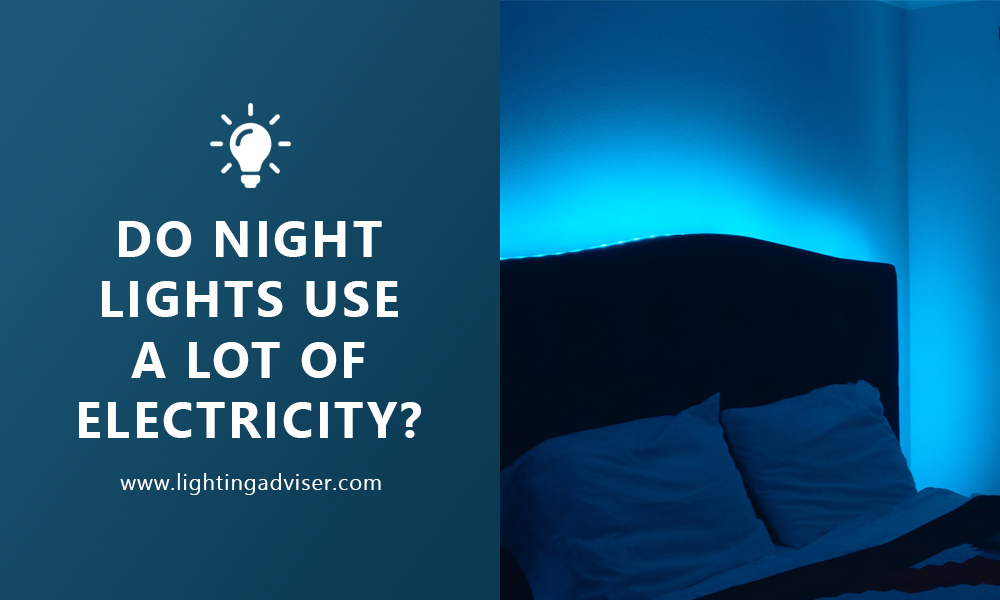We’re an affiliate: Some of the links on this page are affiliate links. We may earn a small commission on purchases made through them.
Night lights are great for providing comfort or some dim lighting for when you need to get out of bed in the dark. But you might be worried that leaving them on throughout the night will use a lot of electricity and run up the bills.
Night lights are energy efficient and don’t use a lot of electricity. LED night lights are about 0.5w which is about a 10th of the electricity used by a standard LED bulb. Based on the average electricity rate in the US, each LED night light will cost around $0.17 per year to run.
In the rest of this guide, we’ll take a look at how night lights compare to regular lights in their electricity usage, then we’ll take a look at what to look for in an energy efficient night light and offer some recommendations.
Contents

How Much Electricity Do Night Lights Use?
The amount of electricity used by a night light or any other type of light is determined by the wattage of the bulb.
Night lights use much less electricity than other lights. Incandescent night lights are usually between 4 – 7 watts and LED bulbs are usually under 1 watt.
In the US, the average electricity rate is 13.19 cents per kilowatt hour (kWh). This means, if switched on 12 hours per day:
- A 4w incandescent night light will cost around $2.31 per year.
- A 0.3w LED night light will cost around $0.17 per year.
How Night Lights Compare to Other Lights
The table below compares the energy usage and cost of running a night light compared to a standard bulb.
The average cost per year is based on the lights running 12 hours per day on an electricity rate of 13.19 cents per kilowatt hour (kWh).
| Type of Light | Approx. Wattage | Avg. Cost per Year |
|---|---|---|
| LED night light | 0.3w | $0.17 |
| Incandescent night light | 4w | $2.31 |
| Standard LED bulb | 8w | $4.62 |
| Standard incandescent bulb | 60w | $34.68 |
As you can see, night lights are very inexpensive to run and LED bulbs of any kind are far more efficient compared with older incandescent bulbs.
Energy Efficient Night Lights
As we just saw, even incandescent night lights don’t use much electricity. But if you’re looking to save as much money as possible there are a couple of things to look for:
- LED: As we’ve seen, LED night lights are by far the most efficient and inexpensive to run.
- Sensors: Some night lights have motion and daylight sensors. These automatically turn the light on when it’s dark and detects motion. The light will then turn off again after a period of no motion (usually around a minutre) or when it senses daylight.
One thing to note about the motion sensors is they can be unreliable. If you purchase an LED night light you’re only looking at cents every year to run it so it’s not worth the hassle if you don’t get along with the sensor. The good news is, these sensors are often optional so just make sure you choose one which allows you to turn the sensor off.
1. AUVON LED Motion Sensor Night Light
If you like the idea of a motion sensor, the AUVON night lights (link to Amazon) are worth checking out. They’re lightweight and have a slim profile so won’t stick out too much and are just 0.3w. These night lights come in a pack of four.
There are two brightness modes and three settings: on, off, and auto. The auto setting is a motion and daylight sensor that turns off after 60 seconds of no motion detected. Unfortunately, the daylight and motion sensors are tied to the same setting so if you don’t get along with the motion sensor you’ll have to manually turn it on and off.
2. GE Soft LED Dusk to Dawn Night Light
If you want to keep things simple, these GE Soft LED night lights (link to Amazon) are great. They have a daylight sensor so you don’t need to worry about turning it on and off, but without a motion sensor which can be unreliable. Obviously this means they will be on all night and use more electricity, but at around half a watt per light, this won’t be a lot.
These night lights are lightweight and compact so won’t get in the way too much and available in packs of two, four, and eight. Unlike the AUVON night lights, these only have one settings and it’s fairly dim so keep that in mind.
Final Thoughts
To wrap it up, night lights (specifically those which are LED) don’t use a lot of energy so you don’t need to worry about racking up a huge bill.
In fact they use around a 10th of the power compared to a regular LED bulb. Each LED night light will cost only around $0.17 per year to run if left on 12 hours per day.
To maximize efficiency even further, you can buy night lights with motion and daylight sensors which only turn on when it’s dark and they detect motion.


